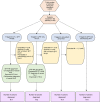Short-term outcomes of a COVID-adapted triage pathway for colorectal cancer detection
- PMID: 33682302
- PMCID: PMC8250907
- DOI: 10.1111/codi.15618
Short-term outcomes of a COVID-adapted triage pathway for colorectal cancer detection
Abstract
Aim: The dramatic curtailment of endoscopy and CT colonography capacity during the coronavirus pandemic has adversely impacted timely diagnosis of colorectal cancer (CRC). We describe a rapidly implemented COVID-adapted diagnostic pathway to mitigate risk and maximize cancer diagnosis in patients referred with symptoms of suspected CRC.
Method: The 'COVID-adapted pathway' integrated multiple quantitative faecal immunochemical tests (qFIT) to enrich for significant colorectal disease with judicious use of CT with oral contrast to detect gross pathology. Patients reporting 'high-risk' symptoms were triaged to qFIT+CT and the remainder underwent an initial qFIT to inform subsequent investigation. Demographic and clinical data were prospectively collected. Outcomes comprised cancer detection frequency.
Results: Overall, 422 patients (median age 64 years, 220 women) were triaged using this pathway. Most (84.6%) were referred as 'urgent suspicious of cancer'. Of the 422 patients, 202 (47.9%) were triaged to CT and qFIT, 211 (50.0%) to qFIT only, eight (1.9%) to outpatient clinic and one to colonoscopy. Fifteen (3.6%) declined investigation and seven (1.7%) were deemed unfit. We detected 13 cancers (3.1%), similar to the mean cancer detection rate from all referrals in 2017-2019 (3.3%). Compared with the period 1 April-31 May in 2017-2019, we observed a 43% reduction in all primary care referrals (1071 referrals expected reducing to 609).
Conclusion: This COVID-adapted pathway mitigated the adverse effects on diagnostic capacity and detected cancer at the expected rate within those referred. However, the overall reduction in the number of referrals was substantial. The described risk-mitigating measures could be a useful adjunct whilst standard diagnostic services remain constrained due to the ongoing pandemic.
Keywords: COVID-19; colorectal cancer; faecal immunochemical tests; qFIT; triage.
© 2021 The Authors. Colorectal Disease published by John Wiley & Sons Ltd on behalf of Association of Coloproctology of Great Britain and Ireland.
Conflict of interest statement
The authors declare no conflicts of interest.
Figures





References
-
- Sud A, Jones M, Broggio J, Scott S, Loveday C, Torr B, et al. Quantifying and mitigating the impact of the COVID‐19 pandemic on outcomes in colorectal cancer. Gut (accepted). 2020.
-
- Song Y, Liu X, Chu Y, Zhang J, Xia J, Gao X, et al. SARS‐CoV‐2 induced diarrhoea as onset symptom in patient with COVID‐19. Gut. 2020;69(6):1143–4. - PubMed
Publication types
MeSH terms
Grants and funding
LinkOut - more resources
Full Text Sources
Other Literature Sources
Medical
Miscellaneous

